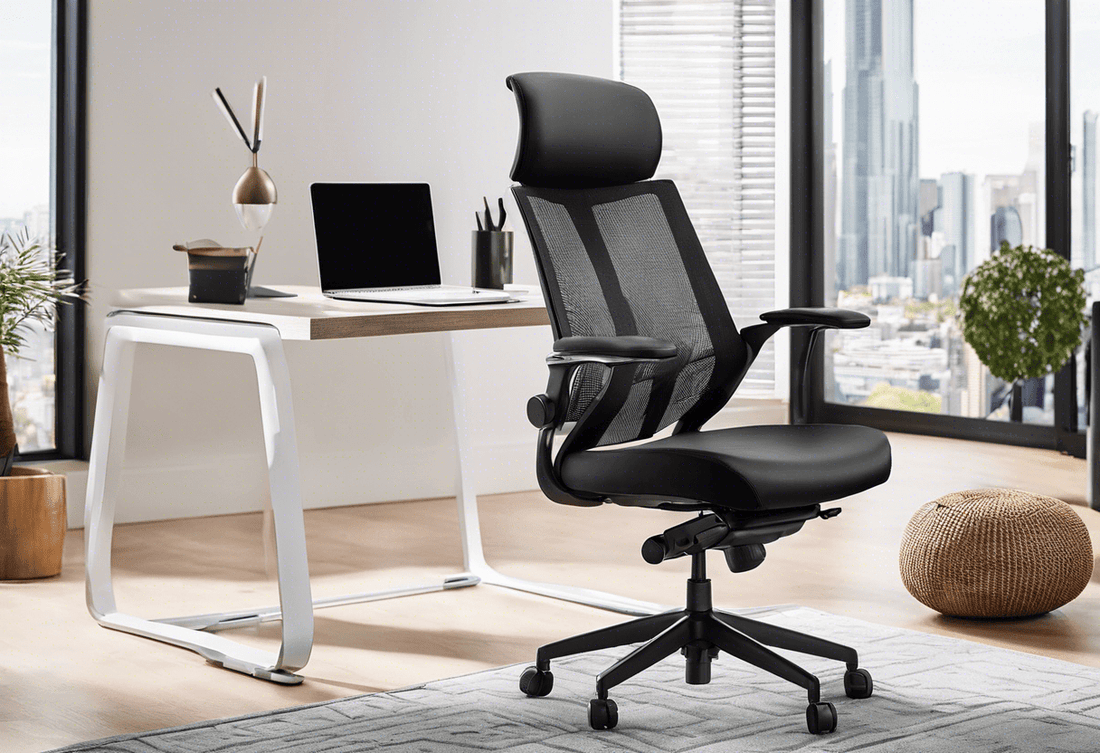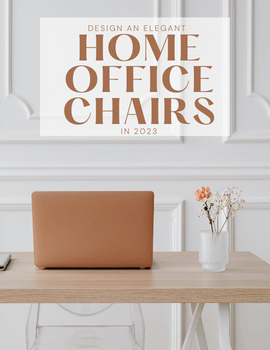5 cosas que debes buscar en tu próxima silla de escritorio

He aquí una descripción general:
- Diseño ergonómico: comprender la ciencia detrás de la comodidad
- Características de ajuste: adapte su silla a su cuerpo
- Soporte lumbar: alivia la tensión en la espalda
- El material importa: tejidos transpirables vs. cuero duradero
- Aspectos esenciales del reposabrazos: cómo lograr una posición adecuada de los brazos
- Giro y movilidad: evaluación del rendimiento de la base y las ruedas
- Capacidad de peso y dimensiones de la silla: adaptándose a su complexión
- Estilo y estética: cómo integrarlos con la decoración de su espacio de trabajo
- Garantía y reputación de marca: Invertir con confianza
- Punto de precio: equilibrio entre presupuesto y calidad
- Consejos adicionales: Mantenimiento y longevidad de su silla de escritorio
Diseño ergonómico: comprender la ciencia detrás de la comodidad
El diseño ergonómico es un campo interdisciplinario que abarca la anatomía humana, la fisiología, la psicología y los principios de ingeniería para optimizar el rendimiento y la comodidad. En el caso de las sillas de escritorio, la ergonomía es crucial, ya que influye directamente en el bienestar físico del usuario. Una silla con diseño ergonómico puede reducir el riesgo de desarrollar trastornos musculoesqueléticos, que suelen producirse por estar sentado durante largos periodos en una silla mal diseñada.
-
Adaptabilidad : Cada cuerpo humano es único, y una silla ergonómica debe tener características ajustables, como la altura del asiento, la inclinación del respaldo, la altura del reposabrazos y el soporte lumbar. Esta capacidad de ajuste garantiza que la silla se adapte al cuerpo de cada persona, promoviendo una postura y alineación correctas.
-
Soporte : Un buen soporte es esencial para mantener la curvatura natural de la columna. Las sillas ergonómicas están diseñadas con respaldos que se adaptan a los contornos de la columna, sujetando la zona lumbar para evitar encorvarse y reducir la tensión en la zona lumbar.
-
Movimiento : El concepto de asiento dinámico consiste en que las sillas permiten o incluso fomentan el movimiento. Las sillas con mecanismo de inclinación o bordes flexibles animan a los usuarios a cambiar de posición, lo que estimula el flujo sanguíneo y reduce la fatiga asociada a las posiciones estáticas.
-
Material : La elección de los materiales también es crucial. Los tejidos transpirables y un acolchado que conserva su forma durante largos periodos son ideales para evitar el sobrecalentamiento y mantener la comodidad durante un uso prolongado.
Comprender la ergonomía no se trata solo de encontrar una silla cómoda; se trata de invertir en un mueble que mejore activamente la salud y la productividad del usuario, adaptándose a la biomecánica natural del cuerpo. Al buscar una silla de escritorio, considerar las características ergonómicas es una inversión en la salud y la eficiencia en el trabajo.
Características de ajuste: adapte su silla a su cuerpo
Al elegir una silla de escritorio que se adapte a las necesidades únicas de su cuerpo, la capacidad de ajuste es fundamental. El objetivo es encontrar una silla que no solo se adapte cómodamente a su cuerpo, sino que también promueva una postura correcta y favorezca el movimiento dinámico durante la jornada laboral. A continuación, se presentan las características de ajuste clave que debe priorizar:
-
Ajuste de la altura del asiento : Mantener los pies apoyados en el suelo y los muslos paralelos es fundamental para una buena circulación y una postura correcta. Busque una palanca de ajuste neumática que le permita ajustar fácilmente la altura de su silla.
-
Soporte lumbar : El soporte lumbar es fundamental para prevenir la tensión. El soporte lumbar ajustable se puede subir o bajar para adaptarse con precisión a la curvatura de la columna.
-
Profundidad del asiento : Las sillas con profundidad de asiento ajustable se adaptan a diferentes longitudes de piernas. Esta característica permite a los usuarios colocar el borde del asiento a una distancia cómoda de la parte posterior de las rodillas, lo que favorece una mejor circulación en las piernas.
-
Tensión de inclinación y reclinación del respaldo : para reducir la presión sobre la columna, una silla debe permitir una variedad de posiciones de reclinación y el control de tensión debe ser adaptable a su peso corporal y preferencias personales.
-
Apoyabrazos : Los apoyabrazos ajustables son fundamentales para la comodidad de hombros y cuello. Deben permitir ajustes de altura, anchura e incluso ángulo para facilitar diversas actividades laborales.
-
Giro y movilidad : una silla que gira fácilmente y tiene ruedas que giran suavemente facilitará el movimiento natural y ayudará a prevenir lesiones por sobreestiramiento.
Invertir en una silla con estas características de ajuste le permitirá configurar su espacio de trabajo según las necesidades de su cuerpo, lo que se traduce en mayor comodidad y productividad. Recuerde que su silla es la base de la ergonomía de su espacio de trabajo, así que elija con cuidado.
Soporte lumbar: alivia la tensión en la espalda
Al elegir una silla de escritorio, el soporte lumbar es una característica fundamental que influye directamente en la comodidad y la salud de la columna vertebral. Anatómicamente, la región lumbar de la columna vertebral se curva naturalmente hacia adentro, y sin el soporte adecuado, permanecer sentado durante períodos prolongados puede provocar encorvamiento. Con el tiempo, esto puede tensar los músculos lumbares e incluso provocar dolor crónico.
Una silla de escritorio eficaz debe incluir:
- Soporte lumbar ajustable : Busque una silla que le permita ajustar el soporte lumbar tanto en profundidad como en altura. Esto le permite adaptar el ajuste a la curvatura de su columna vertebral, proporcionando alivio y soporte específicos.
- Firmeza : Una silla con un soporte lumbar firme es más beneficiosa que un acolchado suave. Un soporte firme mantiene la curvatura natural de la columna, mientras que un acolchado suave puede provocar una postura incorrecta al sentarse.
- Forma y tamaño del respaldo : Un buen respaldo debe adaptarse a la forma de la espalda y ser lo suficientemente ancho como para brindarle un soporte adecuado. Los respaldos contorneados son especialmente beneficiosos, ya que siguen la curvatura natural de la columna.
- Material transpirable : Los materiales que permiten la circulación del aire pueden evitar la acumulación de calor y humedad, lo que puede resultar incómodo durante largos períodos de estar sentado y puede distraerlo de su trabajo.
Incorporar soporte lumbar al diseño de una silla ayuda a mantener la curvatura natural de la columna vertebral, reduciendo la tensión en las estructuras espinales y promoviendo una postura erguida y saludable. Esta característica puede no ser evidente al usar una silla nueva por primera vez, pero sus beneficios a largo plazo para la salud de la espalda y la comodidad general la convierten en un criterio indispensable para su próxima elección de silla de escritorio. Recuerde que, en cuanto al soporte lumbar, la personalización y la capacidad de ajuste son clave para adaptarse a diferentes formas y preferencias corporales.
El material importa: tejidos transpirables vs. cuero duradero
Al elegir su próxima silla de escritorio, la elección del material es fundamental, tanto para la comodidad como para la durabilidad. Las telas transpirables y el cuero resistente son dos materiales populares, cada uno con sus propias ventajas.
Las telas transpirables, como la malla, están diseñadas para facilitar la circulación del aire. Esto es esencial para quienes permanecen sentados durante períodos prolongados, ya que reduce la sudoración y ayuda a mantener una temperatura corporal agradable. Las sillas con respaldo de malla son especialmente populares en climas cálidos o para quienes tienden a calentarse rápidamente. Además, las sillas de tela vienen en una variedad de colores y estampados, lo que facilita su combinación con la decoración de la oficina.
- Ventajas de los tejidos transpirables:
- Mejora la circulación del aire, reduciendo la acumulación de calor.
- Amplia gama de colores y patrones disponibles.
- Generalmente más asequible que el cuero.
Por otro lado, las sillas de cuero son la personificación del profesionalismo y aportan un toque clásico y ejecutivo a cualquier oficina. El cuero es muy apreciado por su durabilidad, resistiendo desgarros y perforaciones que la tela podría sufrir. También es fácil de limpiar: una limpieza rápida con un paño húmedo puede eliminar la mayoría de los derrames y manchas. Además, muchos consideran que las sillas de cuero ofrecen una comodidad superior, ya que el material se adapta a la forma del usuario con el tiempo.
- Ventajas del cuero duradero:
- Resiste el desgaste, ofreciendo longevidad.
- Fácil de mantener y limpiar.
- Se adapta a la forma del cuerpo del usuario para mayor comodidad.
Al elegir entre telas transpirables y cuero resistente, tenga en cuenta el uso habitual de la silla, sus preferencias de mantenimiento y el clima de su entorno de trabajo. También se puede lograr un equilibrio con sillas que combinan ambos materiales, combinando la transpirabilidad de la malla con el atractivo clásico del cuero. La decisión, en última instancia, depende de las necesidades individuales y del equilibrio deseado entre comodidad, estética y durabilidad.
Aspectos esenciales del reposabrazos: cómo lograr una posición adecuada de los brazos
Una silla de escritorio bien diseñada debe incluir reposabrazos que contribuyan tanto a la comodidad como a una buena postura. Una posición correcta de los brazos puede aliviar la tensión en hombros y cuello, reduciendo así el riesgo de lesiones por esfuerzo repetitivo. Al evaluar una silla de escritorio, considere los siguientes factores relacionados con los reposabrazos:
-
Ajustabilidad : Busque reposabrazos con altura ajustable. Esta característica permite a usuarios de diferentes tamaños colocar los brazos en un cómodo ángulo de 90 grados, manteniendo los hombros relajados al escribir o usar el ratón.
-
Ancho y profundidad : Los reposabrazos no solo deben adaptarse a la longitud de los antebrazos del usuario, sino que tampoco deben ser ni demasiado anchos ni demasiado estrechos. Un ancho incorrecto puede provocar que el usuario se estire demasiado o que no proporcione el apoyo adecuado, respectivamente.
-
Capacidad de pivoteo : Algunas sillas ofrecen reposabrazos que pivotan hacia adentro o hacia afuera. Esta adaptabilidad es beneficiosa para tareas que requieren una posición más cercana de los brazos o para realizar pequeños ajustes sin forzar la postura.
-
Material: También debe tenerse en cuenta el material del reposabrazos. Un acolchado suave puede evitar molestias y puntos de presión durante largos periodos de uso.
-
Durabilidad : Los reposabrazos deben ser lo suficientemente resistentes como para soportar el uso diario sin tambalearse ni romperse. Esto garantiza una comodidad duradera y un soporte continuo.
Recuerde que los reposabrazos no son una característica universal. Deben complementar la complexión del usuario y el tipo de trabajo que realiza. Las sillas con reposabrazos personalizables se adaptan a una mayor variedad de usuarios y actividades, lo que las convierte en un componente fundamental a la hora de encontrar la silla de escritorio ideal.
Giro y movilidad: evaluación del rendimiento de la base y las ruedas
Al buscar la silla de escritorio perfecta, una característica esencial, aunque a menudo se pasa por alto, es la base y el rendimiento de las ruedas. Una silla que ofrece un giro suave y fácil movilidad puede mejorar considerablemente la comodidad y la productividad. A continuación, se presentan algunos aspectos a considerar al evaluar estas características:
-
Estabilidad de la base : Se recomienda una base robusta de cinco puntos para una estabilidad óptima. Busque una base de materiales robustos, como aluminio o acero de alta resistencia, que soporte una amplia gama de movimientos y pesos.
-
Mecanismo giratorio : El mecanismo giratorio debe permitir al usuario girar fácilmente con mínimo esfuerzo. Una buena silla ofrece un rango de giro de 360 grados, lo que permite al usuario acceder a diferentes áreas del espacio de trabajo sin esfuerzo.
-
Calidad de las ruedas : Examine la calidad de las ruedas giratorias. Deben estar fabricadas con materiales duraderos que se deslicen suavemente sobre diversas superficies sin causar daños ni requerir una fuerza excesiva.
-
Compatibilidad con el suelo : Asegúrese de que las ruedas sean compatibles con el tipo de suelo, ya sea alfombra, madera o baldosas. Algunas sillas incluyen ruedas especiales o las ofrecen como complemento para evitar rayones y proporcionar un mejor agarre en superficies lisas.
-
Control de ruido y movimiento : Una silla que rechina con cada movimiento puede ser una distracción. Asegúrese de que la silla funcione silenciosamente; las ruedas con un desplazamiento controlado y silencioso mejoran la experiencia del usuario.
-
Bloqueo de ruedas : Si prefiere mayor seguridad o estabilidad, busque sillas con ruedas bloqueables. Estas se pueden activar para evitar que la silla se desplace al subir o bajar.
Recuerde, una silla que facilita el movimiento no solo aumenta la eficiencia, sino que también contribuye a mantener una postura saludable durante la jornada laboral. Pruebe detenidamente la rotación y el balanceo de la silla antes de tomar una decisión, asegurándose de que se ajuste a sus preferencias personales y a las necesidades de su lugar de trabajo.
Capacidad de peso y dimensiones de la silla: adaptándose a su complexión
Al elegir su próxima silla de escritorio, es fundamental considerar su capacidad de peso y dimensiones para garantizar comodidad y durabilidad. Dada la amplia variedad de complexiones, una silla debe ofrecer el soporte adecuado al usuario.
Capacidad de peso
La mayoría de las sillas de escritorio tienen una capacidad de peso específica, que suele oscilar entre 90 y 227 kg o más. Es fundamental elegir una silla que soporte su peso para evitar posibles riesgos de seguridad o daños a la silla con el tiempo.
- Consulte siempre las especificaciones del fabricante para conocer las limitaciones de peso.
- Opte por una silla que pueda soportar al menos entre 10 y 20 libras más que su peso corporal para mayor seguridad.
Dimensiones de la silla
El tamaño de la silla es tan importante como su capacidad de peso. Las dimensiones de la silla determinan si se adaptará cómodamente a sus piernas, espalda y brazos.
- Ancho y profundidad del asiento : Asegúrese de que el asiento sea lo suficientemente ancho y profundo como para sentarse cómodamente sin sentirse apretado. Debe haber algunos centímetros de espacio a ambos lados de los muslos y detrás de las rodillas al sentarse.
- Altura del respaldo : El respaldo debe ser lo suficientemente alto como para soportar toda la espalda. Quienes prefieran un buen soporte para la parte superior de la espalda podrían optar por una silla con un respaldo más alto.
- Apoyabrazos : Los apoyabrazos ajustables pueden ayudar a mantener los brazos en un ángulo cómodo, pero asegúrese de que el ancho total de la silla, incluidos los apoyabrazos, se ajuste a su cuerpo y espacio de trabajo.
Al prestar atención a estos detalles, te aseguras de que tu silla no te cause incomodidad ni problemas de postura. Una silla del tamaño adecuado también puede mejorar tu productividad general, permitiéndote concentrarte en tu trabajo en lugar de cambiar de postura constantemente. Recuerda: la clave para encontrar la silla de escritorio adecuada es que se adapte no solo a tu complexión, sino también a tu entorno.
Estilo y estética: cómo integrarlos con la decoración de su espacio de trabajo
Al elegir su próxima silla de escritorio, es fundamental pensar más allá de la funcionalidad y la comodidad. El estilo y la estética de la silla deben complementar e integrarse a la perfección con la decoración de su espacio de trabajo. Esto garantiza un entorno de trabajo cohesivo y visualmente atractivo, lo que puede beneficiar tanto a la productividad como a la satisfacción general.
A continuación se presentan algunas consideraciones clave respecto al estilo y la estética:
-
Armonía de diseño : Elige un diseño de silla que armonice con el estilo de tu escritorio y oficina. Ya sea que tu espacio sea moderno, tradicional, minimalista o ecléctico, hay una silla perfecta. Busca elementos de diseño como color, forma y material que combinen con la estética de tu espacio de trabajo.
-
Paleta de colores : El color de su silla puede influir enormemente en la estética de su oficina. Seleccione un color que combine con su paleta actual o que aporte un toque especial a su decoración. Los colores neutros ofrecen versatilidad, mientras que los colores intensos pueden aportar un toque vibrante.
-
Materiales y texturas : Los materiales de tu silla de escritorio también pueden influir en su compatibilidad con tu decoración actual. Cuero o malla, madera o piezas metálicas: cada una aporta un toque estético diferente. Presta atención a las texturas y acabados, asegurándote de que combinen con el estilo de tu decoración.
-
Tema consistente : Tu espacio de trabajo podría seguir una temática específica, por ejemplo, industrial, escandinavo o moderno de mediados de siglo. Asegúrate de que tu nueva silla refleje esta temática para mantener una estética uniforme en toda la oficina, acorde con el ambiente deseado.
Cuando su silla se adapta al estilo y la estética de su espacio de trabajo, no solo se integra físicamente, sino también visualmente, mejorando el ambiente laboral. Una silla que combine con su decoración refuerza su identidad de marca para entornos profesionales y sus preferencias personales para oficinas en casa. Merece la pena invertir tiempo en encontrar una silla que satisfaga tanto sus necesidades ergonómicas como sus deseos estéticos para lograr un espacio de trabajo realmente perfecto.
Garantía y reputación de marca: Invertir con confianza
Al considerar la compra de una nueva silla de escritorio, es fundamental examinar la garantía y la reputación de la marca. Estos factores son la base de la confianza del consumidor y ofrecen una idea de la calidad y durabilidad que se puede esperar de la inversión.
- Una garantía completa refleja la confianza del fabricante en su producto. Busque garantías que cubran un período considerable e incluyan varios componentes de la silla. Algunas marcas ofrecen una garantía limitada de por vida para ciertas piezas, lo que implica un compromiso con la satisfacción del cliente a largo plazo.
- Comprenda los detalles de la garantía. Idealmente, debería cubrir la funcionalidad de la silla, incluyendo mecanismos como el ajuste de altura, la tensión de inclinación y el giro. Los términos de la garantía imprecisos o excesivamente limitados pueden ser una señal de alerta.
- Evalúe la capacidad de respuesta y el apoyo de la marca al atender las reclamaciones de garantía. Las experiencias positivas de servicio al cliente indican que la empresa valora a sus clientes y respalda sus productos.
Además, la reputación general de una marca puede indicar el nivel de calidad que se puede esperar.
- Investigue las opiniones y testimonios de los clientes. Estos pueden servir como referencia para evaluar el rendimiento real de sus sillas.
- Investigue los premios o certificaciones independientes que la marca haya recibido. El reconocimiento de organismos del sector puede ser un testimonio del compromiso de una marca con la excelencia y la innovación.
- Preste atención a la trayectoria de la marca en el mercado. Las marcas consolidadas con una trayectoria de consistencia suelen ser opciones confiables.
En conclusión, una garantía sólida y una marca reconocida no son simples argumentos de venta; son garantías de que su inversión está protegida. Le permiten invertir en su próxima silla de escritorio con confianza, sabiendo que la marca se preocupa tanto por su satisfacción como por el valor duradero de su producto.
Punto de precio: equilibrio entre presupuesto y calidad
Al elegir una silla de escritorio, el precio es un factor importante que se correlaciona directamente con la calidad. Sin embargo, no se trata solo de optar por la opción más cara. Es necesario encontrar un equilibrio, consiguiendo una silla que ofrezca comodidad, funcionalidad y durabilidad superiores sin afectar su presupuesto. Considere los siguientes aspectos en relación con el precio y la calidad:
- Evalúe su presupuesto : Antes de comenzar su búsqueda, determine un presupuesto realista. Esto le ayudará a reducir las opciones sin caer en gastos de alta gama que podrían resultar excesivos para sus necesidades.
- Comprenda la relación costo-beneficio : Un precio más alto no siempre garantiza una mejor silla. Algunas sillas se valoran por su marca o diseño, más que por su ergonomía o durabilidad. Por el contrario, una silla de precio moderado podría ofrecer las características esenciales sin los extras que encarecen el precio.
- Invierta en características clave : Priorice la inversión en características cruciales como el soporte lumbar ajustable, la profundidad del asiento y los reposabrazos. Estas influyen directamente en su comodidad y salud, por lo que vale la pena invertir en ellas.
- Considere los costos a largo plazo : Una silla barata podría necesitar un reemplazo antes, lo que a la larga implicaría un aumento en los costos. Por el contrario, invertir un poco más inicialmente en una silla de alta calidad podría representar un ahorro a largo plazo.
- Busque garantías : Una buena garantía puede ser una señal de la confianza del fabricante en su producto. También le brinda la tranquilidad de no tener que afrontar gastos inesperados si la silla presenta algún problema.
En conclusión, si bien es importante ajustarse al presupuesto, es igualmente vital considerar el valor total que ofrece una silla de escritorio. Un enfoque equilibrado al evaluar el precio y la calidad puede resultar en una compra satisfactoria que combine sostenibilidad, comodidad y asequibilidad.
Consejos adicionales: Mantenimiento y longevidad de su silla de escritorio
Invertir en la silla de escritorio adecuada es importante, pero mantenerla puede garantizar su buen funcionamiento durante años. Aquí tienes algunos consejos de mantenimiento y durabilidad:
-
Inspección regular: Inspeccione su silla con frecuencia para detectar cualquier signo de desgaste o daño. Revise las ruedas, los reposabrazos y las palancas de ajuste para asegurar su correcto funcionamiento. Apriete los tornillos o pernos sueltos para evitar daños mayores.
-
Limpieza: Mantenga la silla limpia para prolongar su vida útil. Utilice limpiadores adecuados para el material de la silla, ya sea malla, cuero o tela. Limpie las superficies duras con un paño húmedo y utilice una aspiradora con cepillo para eliminar el polvo y los residuos de la tapicería.
-
Lubricación: Lubrique periódicamente todas las piezas móviles para garantizar un funcionamiento suave. Esto incluye las ruedas y los mecanismos de giro e inclinación. Para obtener mejores resultados, utilice un lubricante a base de silicona y evite los productos derivados del petróleo, que pueden degradar ciertos materiales.
-
Evite el exceso de peso: Siga las recomendaciones de peso del fabricante. El exceso de peso puede forzar y desgastar el mecanismo y la estructura de la silla con el tiempo.
-
Protección del piso: use una alfombra o una cubierta protectora en el piso para minimizar el desgaste de las ruedas de la silla y facilitar un movimiento suave.
-
Evite la luz solar directa: coloque su silla lejos de la luz solar directa, ya que los rayos UV pueden provocar la decoloración y degradación de las telas y los materiales con el tiempo.
-
Reparaciones profesionales: Si la silla está dañada, considere que un profesional la repare. Las reparaciones caseras pueden ser tentadoras, pero las reparaciones incorrectas podrían anular la garantía o causar daños mayores.
Al incorporar estos consejos de mantenimiento y longevidad, la inversión en una silla de escritorio de calidad estará protegida, lo que garantiza que seguirá siendo una herramienta cómoda y de apoyo en el espacio de trabajo durante los próximos años.

















